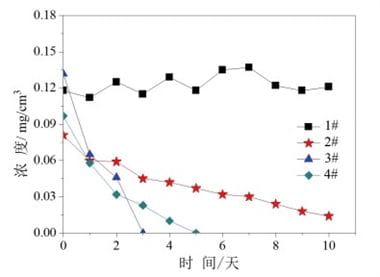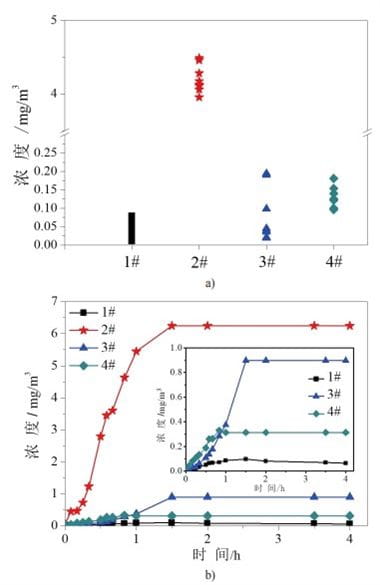Research on the Application of Formaldehyde Sensors to Air Conditioning

Abstract
The working life and long-term stability of electrochemical formaldehyde sensors are the main obstacles restricting the popularization and application of formaldehyde sensors in the field of home appliances. Among them, how to improve the long-term working stability of the internal core components of the formaldehyde sensor is the key problem to solving the current formaldehyde sensor’s short service life and poor resistance to external harsh environments. In this study, we develop a formaldehyde sensor based on a new electrolyte and anti-interference catalyst formulation.
In the air-conditioning mode, the simulated scenario experiment, we carry out the anti-alcohol interference experiment and the life experiment in a targeted manner. The experimental results show that the new electrolyte and anti-interference catalyst formulation optimized and designed in this experiment can effectively improve the long-term working stability and working life of the sensor, and improve the anti-interference ability of the formaldehyde sensor to deal with external environmental gas pollution sources. This research plays an important role in broadening the application of electrochemical formaldehyde sensors in the field of home appliances.

Introduction
In recent years, with the development of the Internet and people’s attention to air, the demand for formaldehyde sensors in smart homes, vehicle equipment, smart mobile terminals, and other fields is increasing day by day. However, the working life and long-term stability of electrochemical formaldehyde sensors are the main obstacles that restrict their popularization and application in the field of home appliances. The sensor has a short life and long-term response to external environmental performance degradation, which often results in inaccurate detection results and false alarms in the detection system, and further restricts the wide application of sensors in various fields. The long-term stability of electrolyte materials and catalysts is one of the bottlenecks restricting the application of formaldehyde sensors.
Therefore, we develop a long-term formaldehyde sensor and further carry out simulated scene experimental analysis and long-term work stability research on the formaldehyde sensor element based on the optimized design of the new electrolyte and anti-interference catalyst formulation. The experimental results show that the new electrolyte and anti-interference catalyst formulation based on this study can effectively improve the sensor’s resistance to damage and interference caused by external high temperatures, high humidity, high concentration, and other harsh environmental changes, and effectively improve the long-term working stability of the formaldehyde sensor. This research has a positive effect on broadening the application of formaldehyde sensors in the field of home appliances.
The experiment
Part 1
The formaldehyde sensor used in this experiment is an electrochemical sensor element. First, the acid-base electrolyte commonly used in the industry replaces the self-developed new electrolyte. At the same time, we spray the self-developed anti-poisoning catalyst formula slurry on the surface of the new electrolyte membrane to make the sensor electrode, and then assemble the cover body, support sheet, electrode, dust-proof breathable film, signal lead-out PCB board, and metal leads. After that, the fabricated sensor gets older for 1 month under specific working conditions. Among them, the anti-interference catalyst slurry formulation mainly includes platinum powder, nano-carbon, and an appropriate amount of doped multi-system precious metals and other active ingredients. The performance of the sensor is tested by using the static test method.
First, the sensor element was put into a sealed test chamber, and a specific concentration of test gas was added and mixed uniformly. Then, a spectrophotometer was used to sample and test, and further comparative analysis was carried out between the homemade and commercial electrochemical formaldehyde sensors. Among them, 1# is the formaldehyde sensor based on the new electrolyte and anti-interference catalyst slurry formulation in this study; 2#, 3#, and 4# are commercial electrochemical formaldehyde sensors produced by Company A, Company B, and Company C. The above electrochemical formaldehyde sensors are based on the working principle of fuel cells.
Part 2
The test scheme of each simulated scene experiment is as follows:
(1) Simulated high-temperature experiment: We place the sensor in a test box with a temperature of 70°C for 168 hours.
(2) Simulated low-temperature experiment: We place the sensor in a test box with a temperature of -20℃ for 168 hours.
(3) Simulated high-temperature and high humidity experiment: We place the sensor in a test box with a temperature of 60°C and a humidity of 93% for 168 hours.
(4) Life-acceleration experiment: We place the sensor in a sealed chamber with a high concentration of 10 mg/m3 formaldehyde for 500 hours.
(5) Simulated alcohol interference experiment: Plan 1: Test the sensor in a test chamber with 30m3 and an alcohol concentration of 10 ppm. Plan 2: we place A certain brand of liquor with 53 vol%, and four glasses of 180 mL wine in a home restaurant of 70m2 for 4 hours. The air conditioner is refrigerating with a high wind speed, and the doors of each room are in the same open and closed state as usual; we install the sensor in the side area of the hanging air conditioner.
Part 3
Therefore, for the formaldehyde sensor in this study, the influence of high temperatures on the sensor is a little. In the actual transportation, storage, or working process of the air conditioner, the sensor can ensure the reliability of continuous operation and storage under extremely high temperatures. For the current commercial formaldehyde sensors 2#, 3#, and 4#, traditional liquid acid-base electrolytes are used as proton conduction media. Under high temperatures, the water in the electrolyte is easily lost, which leads to an increase in the system concentration. As a result, the ability of the electrolyte system to conduct protons gradually deteriorates, or even loses its ability to conduct protons. At the same time, at a long-term high temperature, it may seriously damage the reactivity of the internal catalyst material.
The above problems will eventually cause sensors 2#, 3#, and 4# to be unable to resist the destructive effect of the external high-temperature environment. The sensor 1# in this study adopts a new type of electrolyte system, which is different from the current traditional electrolyte system. It has excellent thermal stability and chemical stability, and moisture can be effectively and stably confined in the electrolyte system. After treatment at a high temperature, the ability of the electrolyte system to conduct protons will not be destroyed. Therefore, compared with the current commercial sensors 2#, 3#, and 4#, the formaldehyde sensor 1# in this study has the characteristics of high-temperature resistance at 70°C, which lays the foundation for ensuring its application in the air conditioner.

1. Figure 1 High-temperature decay curve of sensors
Anti-alcohol interference tests
Part 1
In order to verify that the sensor can resist the false detection and false alarm caused by family life, we reflect the anti-interference ability of the sensor to continuously work under the environmental conditions with interference sources by simulating the scene of drinking in a family gathering for a long time. It shows the formaldehyde concentration output result of the sensor in Figure 2; People carried out the anti-alcohol interference experiment in a user’s home with an area of 70m2, and it shows its distributions of internal layout and test point in Figure 3.

2. Figure 2 The formaldehyde concentration output of the sensor in the anti-alcohol interference experiment

3.Figure 3 The distribution of home interior layouts and test points
Part 2
Figure 2a is the output of the sensor’s anti-alcohol interference performance in an experimental chamber with an area of 30m3 by creating an environment with 10 ppm alcohol to simulate a drinking scene. Through comparison, we find that in the atmosphere of 10 ppm alcohol, the commercial formaldehyde sensor 2# is seriously bursting, and the displayed formaldehyde concentration is 4 to 5 mg/m3, far exceeding the national standard safety line of 0.1 mg/m3.
The formaldehyde concentration output by commercial formaldehyde sensors 3# and 4# also reaches 0.1 to 0.2 mg/m3, which exceeds the national standard safety line, that is to say, under a certain alcohol concentration environment, the currently commercialized formaldehyde sensors 2#, 3#, and 4# are weak in resisting alcohol interference. When we apply them to air conditioners, there will be obvious false detections and false alarms. For the formaldehyde sensor 1# based on the new electrolyte and anti-interference catalyst slurry formulation in this study, under an atmosphere of 10 ppm alcohol, the formaldehyde concentration of the formaldehyde sensor is less than 0.1 mg/m3, which is lower than the national standard safety line, and the anti-alcohol interference is less than 1%.
Part 3
At the same time, we further simulate the scenario of drinking for 4 hours in the user’s home to verify the anti-interference ability of each sensor, as shown in Figure 2b. The formaldehyde sensor 2# is still seriously bursting, and the formaldehyde concentration output by formaldehyde sensors 3# and 4# also reaches 0.15 to 0.35 mg/m3, which exceeds the national standard safety line. However, the concentration output of the formaldehyde sensor 1# in this study is less than 0.05 mg/m3 in the long-term range, which is significantly lower than the national standard safety line.
It has good resistance to alcohol interference. We can apply it to air conditioners, which will effectively reduce the probability of false detection and false alarms and improve the user experience. The highly selective active composition of the multi-precious metal system in the catalyst slurry formulation designed in this study may mainly cause the above differences in anti-interference ability. This can significantly reduce the adsorption and chemical action of alcohol molecules, thereby showing excellent anti-alcohol interference ability.




